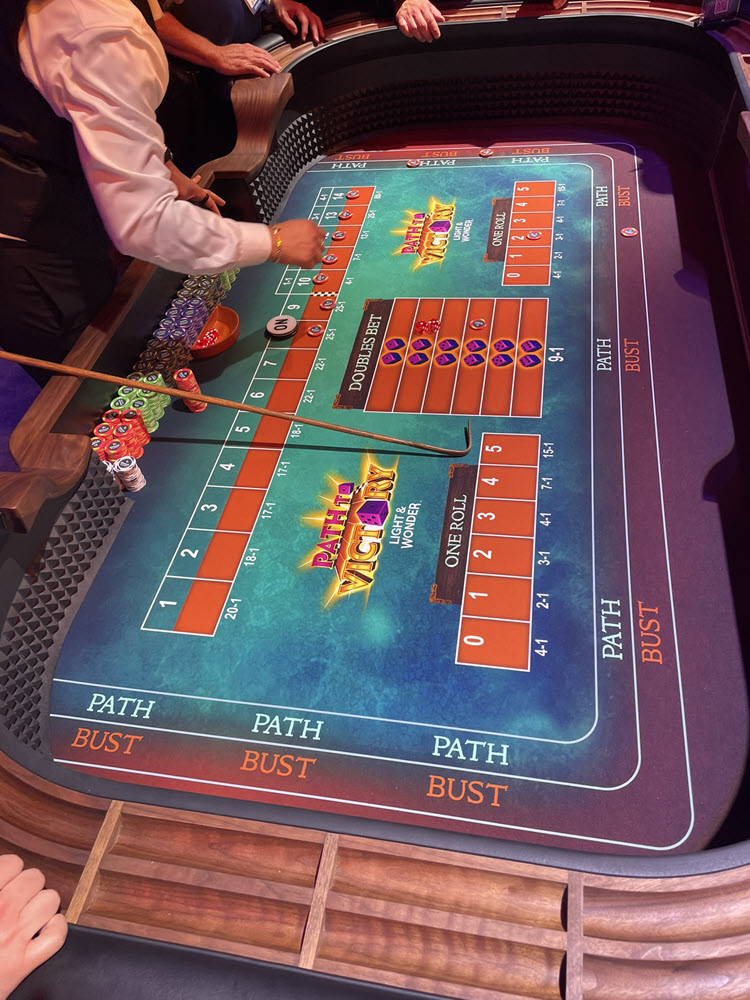Poll
 | 1 vote (20%) | ||
 | 1 vote (20%) | ||
 | 3 votes (60%) | ||
 | 2 votes (40%) | ||
 | 1 vote (20%) | ||
| No votes (0%) | |||
 | 2 votes (40%) | ||
 | 2 votes (40%) | ||
 | 2 votes (40%) | ||
 | 2 votes (40%) |
5 members have voted

Path to Victory is a new dice game I saw at the Light & Wonder booth at the Global Gaming Expo. Briefly, two dice are rolled and a puck advances on a board according to the different between the two dice. For example, a 1-4 would advance the puck 3 spaces. A double ends the game. Bets are placed according to how far the puck will advance.
For all the rules and analysis, please click the link on the name of the game. Those who like Markov Chains will be especially interested. I wish Mustang Sally were still around for this one.
I welcome all questions, comments and corrections.
The question for the poll is would you play Path to Victory? Multiple votes allowed.
Before anyone calculates the house edge, I will note an important rule that I saw in a demonstration. If you roll doubles at the beginning, you get to roll again.
The inventor told me that betting on the 11 has about 1.5% house edge which is great. The inventor then asked me to bet on different numbers (with the highest house edge) :D So I apologize if he is reading this, but I think that the mathematicians in this forum would have found out which bet has the lowest house edge pretty quickly anyways. I also think that knowing how to play a game optimally increases the likelihood that players will keep coming back to a game.
Anyways, let me quickly elaborate on the "One Roll" house edges.
One Roll 0: 16.6666%
One Roll 1: 16.6666%
One Roll 2: 11.1111%
One Roll 3: 16.6666%
One Roll 4: 11.1111%
One Roll 5: 11.1111%
I assume it's just (1/3 * 1/6) * 21 but that would give a house edge about 100%.
1/3 comes from (10/(36-6)) the likelihood of starting your journey with a "one difference" and then 1/6 comes from the likelihood of rolling a "double" on your second roll.
Quote: harrisI am struggling trying to figure out the House Edge of "step 1".
I assume it's just (1/3 * 1/6) * 21 but that would give a house edge about 100%.
1/3 comes from (10/(36-6)) the likelihood of starting your journey with a "one difference" and then 1/6 comes from the likelihood of rolling a "double" on your second roll.
link to original post
You win if the first roll's numbers differ by 1, and the second roll's numbers are a pair.
There are 10 ways to roll a difference of 1 (1-2, 2-3, 3-4, 4-5, 5-6, 2-1, 3-2, 4-3, 5-4, 6-5) and 6 ways to roll a pair, so the probability of winning = 60 / 36^2 = 5/108.
It pays 20-1, so the EV is 5/108 x 20 - 103/108 x 1 = -3/108 = -1/36 = -0.027778.
Quote: harrisI am struggling trying to figure out the House Edge of "step 1".
link to original post
The probability of winning the step 1 bet is pr(difference of 1 on first roll) * pr(doubles on second roll) = (11/36)*(6/36) = 4.6296%.
The house edge is 1 - 21*0.046296 = 2.78%.
Wouldn't this increase the chance of a difference of 1 on the first roll?
Instead of 10/36, it would be 10/30, right?
Obviously I am probably missing something since GLI has presumably already analyzed this.
Are there written rules anywhere?
Quote: harrisFrom my understanding of the rules, you redo the first roll if you get doubles. Instead of 36 possible first rolls, there would only be 30.
link to original post

Here is a picture of the rule card, which I don't see mention that. My figures also agree with those of GLI.
These rules make sense, the dealer I was watching might have just let everyone redo their bets so that their demonstration wouldnít end after a single roll.
Do you have the GLI sheets? I have been looking for them but canít find them. My plan was going to be to stay up until 5am calculating the house edge but on second thought sleep would be nice if those percentages are already publicly available.
Quote: harrisDo you have the GLI sheets? I have been looking for them but canít find them. My plan was going to be to stay up until 5am calculating the house edge but on second thought sleep would be nice if those percentages are already publicly available.
link to original post
The GLI report was given to me by L&W. I think it was implied that its for my eyes only. Their numbers match mine on the WoO page so you shouldn't really need it.
Thanks very much for putting your work online to spread mathematical knowledge :)
I am a little surprised that there only appears to be one pay table.


